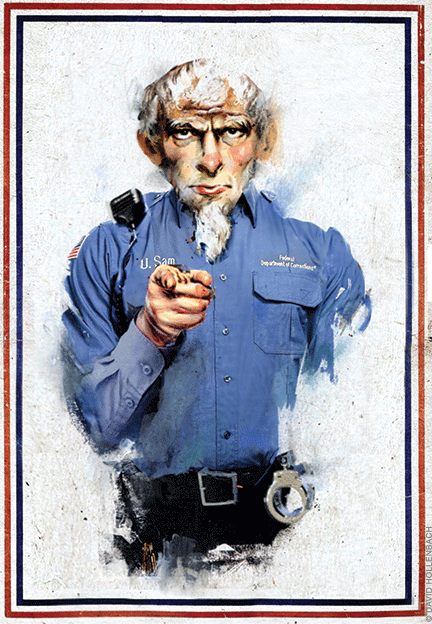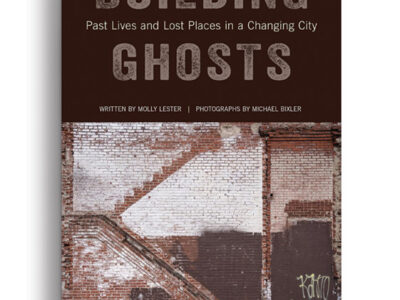
The numbers only hint at the reality. But here are a few:
• From 1973 to 2009 the US prison population (state and federal) increased more than 700 percent—from about 200,000 to 1.5 million. Another 700,000 are held daily in local jails.
• The US has the highest per-capita incarceration rate in the world by far—730 per 100,000—and holds close to 25 percent of the world’s prisoners, despite accounting for only 5 percent of the world’s population.
• More than 8 million adults in the US—one out of every 23—are under some form of state control (jail, prison, probation, parole, et cetera).
• Two million young children have a parent in prison.
• Six million adults—roughly 2.5 percent of the voting-age population—have been disenfranchised temporarily or permanently because of a criminal conviction.
• African Americans are the most incarcerated group overall: 2,285 per 100,000, and the rate for black males (4,749) is off the charts. But it’s bad for Hispanics (979), too, and even for whites the incarceration rate is higher (400) than anywhere else in the world but Russia and the Democratic Republic of Georgia.
According to Penn political-science professor Marie Gottschalk, neither racism nor the war on drugs fully explains the problem; police reform isn’t enough to solve it; and even focusing on the root causes of crime might be a distraction from stepwise improvements that could make a substantial difference faster.
“The huge prison buildup of the past four decades has few ardent defenders today,” she writes in Caught: The Prison State and the Lockdown of American Politics, published earlier this year by Princeton University Press. “But reforms to reduce the number of people in jail and prison have been remarkably modest so far.” Though a bipartisan movement to relax federal sentencing and revamp the probation system has been gathering steam, fewer than 10 percent of the men and women behind bars are in the federal system.
Gottschalk, who recently served on the National Academy of Sciences Committee on the Causes and Consequences of High Rates of Incarceration, has written extensively on the criminal-justice system. And by taking her Penn students to Philadelphia-area jails, she also literally brings the classroom to her subject, and vice versa.
Gottschalk spoke with Gazette senior editor Samuel Hughes about America’s prison predicament.
What’s behind the incredibly high incarceration rate in the US?
Certain forces came together in the ’60s and ’70s that created incentives to politicize crime in a way that it hadn’t been politicized before. That coincided with a blip up in the crime rate—which was not sustained, but politicians acted like it kept going up and up. We also elect judges, and we elect prosecutors. Most of them get their jobs through a very political process, either election or political appointment, even on the Supreme Court. That fundamentally makes the United States different from other countries. Politicians elsewhere are aware that you can exploit people who commit crime for political benefit, but there are limits to what they can do—there’s this insulation of having unelected prosecutors and judges, so they can temper the public mood in a way that doesn’t happen here.
I largely reject the idea—and the public-opinion data seems to support this—that Americans are overwhelmingly more punitive than in other countries. That punitiveness is often driven by politicians. On certain points, like support for the death penalty today, yes, Americans are more punitive. But in the 1960s, the United States had the lowest support for the death penalty of any advanced industrialized country.
Let’s pretend you’ve been appointed the nation’s criminal- justice czarina, and can change the ways we make and enforce laws at the state and federal levels. What would you do?
We need comprehensive sentencing reform, which would mean getting rid of mandatory minimums, getting rid of habitual-offender laws, three-strikes laws. We need to ameliorate the dehumanizing, degrading conditions in prisons and jails and not just think that this is a question of too many people in prison and jail. We need to get rid of all the restrictions on people with criminal records—the voting restrictions, the restrictions on public housing, the restrictions on student loans and employment—unless they’re absolutely critical to public safety.
We need to recognize the enormous discretion that people have at every level of the law-enforcement system to do something, even if we don’t pass legislation. Prosecutors have enormous discretion to decide how many crimes to charge someone with and how punitive to be. The head of the Federal Bureau of Prisons has a lot of rules on the books he could be using now to let people out early, and he’s not. There’s a lot of discretion that people aren’t using.
So it’s not just a question of saying what policies we need, but of what are the politics we need.
You say it’s a mistaken public belief that many released prisoners become serious repeat offenders and are the big drivers of crime rates. What’s behind that belief, and what are the consequences?
Often when we have a sensational crime by a released offender that hits the front page, politicians and public officials act like this is an ordinary, commonplace crime rather than an exceptional, sensational crime—which contributes to the climate that every parolee who comes out of the system is ready to go kill a police officer. So it’s partly that the media loves to latch onto these sensational crimes, but also that the politicians fail to look at the data and educate the public when these things happen.
A lot of people think that if we ended the war on drugs, the over-incarceration problem would disappear. How did that narrative take hold?
People can get their heads around the idea that we made this big mistake with the war on drugs. There are a lot of people in prison who are very safe except for the fact that they are drug users, and many of them are there for possession and not for selling. But as anybody who watches The Wire knows, it’s not always so easy to separate out who’s in the drug game, who’s not in the drug game, and who’s involved with or not involved with more serious crime.
If we take everybody out of state prison whose primary offense is a drug offense, on average we will reduce the state prison population across the country by about 16 percent, according to the latest data. It’s not going to fundamentally change mass incarceration, though it is an enormous step that needs to be taken, and it will have an important impact on certain demographic groups, notably African-American women.
There’s still a disproportionally high rate of violent crime in certain poor African-American neighborhoods. How do our current laws and practices make the problem better or worse?
The most fundamental misconception about this problem is that if you lock up more people, you’re going to radically reduce your crime rate. I worked on this problem the past couple of years as a member of National Academy of Sciences committee on high rates of incarceration. We concluded, after examining the best science available, that the rise in incarceration rates likely had, at most, a very modest effect on reducing the US crime rate. So the idea that we can go into poor communities, lock many people up, and think we’re going to have a dramatic impact on reducing crime—if anything it may actually be increasing crime. By sending people to jail, sometimes they become more criminogenic. Also, you destabilize their families, you destabilize their communities, you reduce their life chances of earnings and employment.
I’m not saying that people who commit serious crimes should not pay some kind of cost. But the science is very, very solid that locking so many people up with decades-long sentences—versus two-, three-, five- or 10-year sentences—doesn’t necessarily have much of an impact on reducing crime. And our sentences are so long that, if you reduce a sentence from 40 to 20 years, 20 years is still a huge sentence. It is way beyond the amount of time that someone sentenced to “life” typically serves in prison in Western Europe.
Aren’t crime rates falling overall?
Crime has gone down. What we’ve seen in the last few years is that crime has become much more concentrated in certain areas and certain neighborhoods, while other areas have become safer. The celebration that we’re at historic lows for crime that we haven’t seen since the Eisenhower years should be more muted. Even though US crime rates—including rates for violent crime—are down even in poor, inner-city communities, we still have concentrated pockets of crime—especially violent crime—that are extraordinarily high compared to other industrialized countries.
Can we really fix the over-incarceration problem without fixing the deeper systemic issues?
Some people say that to solve this problem we have to address all the root causes of crime—you know, poor healthcare, poor schools, lack of jobs, residential segregation, insufficient community services and after school programs—in order to reduce mass incarceration. If we have that goal, we’re never going to solve this problem, because then we have to solve all the big things that we haven’t solved for decades first.
But there are basic policy issues we can address to reduce our prison population. Other countries have done it, and they didn’t address all those root causes. They sought comprehensive sentencing reform, changed the laws, changed the policies, and basically sent fewer people to prison. And the people they sent there, they sent for less time.
The long-term, more fundamental problem is these extraordinary pockets of high crime and high violence. And for that you need to address those root causes. But in the meantime, we shouldn’t be locking up so many of the poor disadvantaged people of color from these communities.
Where do you draw the line? I mean, there are some people who really should be locked up because they’re dangerous.
So tell me, who’s a dangerous person?
Someone who’s murdered or violently assaulted someone before and doesn’t have a problem with doing it again.
What we’ve lost in this country is the distinction between someone who’s committed a violent act and someone who’s still a violent person —who’s still a major threat to public safety. In the past, for homicide, people typically served 12, 13, 14 years. If you didn’t hurt anybody else in prison, you kept your head low, you were released. You got a commutation. You got out on parole. We didn’t say you would be defined by that one crime forever.
So when you go back again to the problems with the politicians and public officials, there’s an unwillingness to educate the public about this. That, yes, you had a crime of passion, you were 16 years old, you stabbed your girlfriend 15 times. You’re now 50 years old. All the data shows that you age out of crime.
We do have this kind of redemption idea in American culture—that, yes, you have sinned, but you can redeem yourself. That’s a very powerful strand of our culture that can be pulled upon for reform in a positive direction.
There’s certainly plenty of racism in the criminal-justice system. But is that really the whole story?
We love to measure the racial disparities and to show that there’s this huge black-white racial disparity. It’s about five-to-one, six-to-one in incarceration now. And then we stop. We don’t look at the underlying causes of those racial disparities in geography, socioeconomic status, healthcare status, how different institutions sort blacks and whites differently.
I’d take it a step further and say we don’t talk too much about how white incarceration rates in the United States compare to the incarceration rates of other countries. For African Americans, so many key indicators are off the charts and different from whites—you know, infant mortality, unemployment, mass incarceration. We forget that these indicators are often off the charts—just not as much—for whites in this country, especially poor whites, and that the United States has a large and growing population of dispossessed whites. When you compare the black to white incarceration rates in the United States, whites look comparatively fine. But the incarceration rate of 400 per 100,000 for whites in the United States is about two and a half times the incarceration rate of the most punitive countries in Western Europe, and about five or six times the rate of the least punitive ones. So it’s not just enough to document those disparities, and then say, “Oh, it’s racism.”
Do you think the recent protests in Ferguson and elsewhere will lead to a reexamina tion of racial and criminal codes?
We’ve had these other moments of urban unrest, and it often gets channeled into: “We need to professionalize the police more. We need to train them more. We need to add more diversity.” We’ve done all that with police. We’ve done it in a lot of communities. It’s not working that well. Certainly the police could be doing their jobs better. They could be managed better. But reducing it to a technical professional issue, like putting more cameras on police, is trying to find a really neat fix for the police. In fact, police are a lot more accountable than prosecutors are, but we’re not talking that much about the role of prosecutors in all this. I hope Ferguson and other recent political unrest over the police will spur a wider and deeper discussion of not only mass incarceration but also the wide-reaching carceral state, which is metastasizing and deforming US society and democracy.





What do you expect will happen when you release a prisoner back into the community that contributed to his incarceration? When you don’t give him the opportunity for housing AWAY from that community, refuse him foodstamps and healthcare, or supply him with job opportunities that will help support him and his family? He successfully completed a job program during his time then was released without guidance or job prospects. He got a job washing cars, but had to remain in his family’s home. An old girlfriend got mad and called in a tip to the police about the home he was occupying. Turns out, another family member was still involved in the “business.” So he got sent back to prison.
Couldn’t there have been a guidance councilor available to help him apply for section 8 housing, food stamps, transportation pass for a month or two, and job applications PRIOR to his release?? Releasing them unprepared is just setting them up to fail! Another family torn apart and children left without a father. Guess what his 10- and 12-year old sons are doing now to make money? Guess who their “father figures” are in THAT neighborhood? Guess what’s going to happen to his little daughter when she figures out what really happened to her dad and what her extended “family business” is all about? Might as well make room for three more!